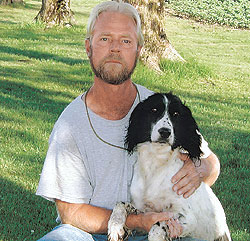By James B. Spencer
 This tip is from Hal Cheney of Linden Kennels, 1812 275th Street, Mount Pleasant, IA 52641; (319) 385-5589; website www.lindenkennels.com; e-mail hal@lindenkennels.com. Hal has been training all sporting breeds professionally for 24 years, specializing in spaniels. He has competed in spaniel field trials, but now trains mostly hunting dogs. He breeds English springer spaniels. |
"Many factors contribute to the risk of overheating," Hal said, "like temperature, humidity, wind strength (or lack thereof), sunshine or clouds, cover density, and the physical condition of the dog. You have to know your dog, and you have to watch your dog, and then you have to use common sense to determine when he's in danger of overheating."
Hal stressed that dogs are more susceptible than humans to overheating, primarily because they don't sweat to stabilize their body temperature; they can only pant. Then, too, while training, zig-zagging spaniels move faster and cover more ground than their walking handlers. He said the signs of overheating are progressive: first, the dog pants excessively; then he appears distressed; then he staggers drunkenly; and finally he collapses, after which he will die very quickly.
"When your dog shows the first signs of overheating," he said, "stop training, get him out of the sun, give him a drink of water, and start wetting him down thoroughly. As you soak him, rub the water down into his skin with your hand. And then, above all, learn from that experience. Don't ever let it happen again!"
Hal said that the ideal warm weather training area for spaniels has brome-grass cover mowed to a height of about 16 inches, as you can find in a field that has been recently mowed for hay. You should avoid tall, thick cover that tangles in your dog's coat.To keep your dog cool while traveling to and from the training grounds, Hal recommends plenty of ventilation plus perhaps frozen milk jugs full of water in the dog's crate. He will lick them and rub against them. While on the training grounds, but not actually working, you should keep your dog in a shady area, with drinking water and good ventilation, and if possible with a fan blowing on him
While actually running, your dog relies on your judgment as to when he's had enough. You need to know his physical condition, and you must watch him for any sign of overheating. You should always err on the side of caution. Give him short runs and frequent drinks. For the latter, you need to carry water with you while working your dog.Hal said that scenting conditions can be poor during warm weather, especially in heavy cover with little or no wind. Thus you should do your training in lighter cover and only when there is a reasonable breeze blowing.
| Warm Westher Training | 

Don't miss tips for your pointer, here., and your retriever, here..
|
|
"Then, too," he added, "Your pooch can't smell much of anything when he's panting with his tongue hanging out! With a young spaniel, don't use birds that run in the summer. Such birds will confuse the pup and booger up his flush. He'll begin to take a long time to put birds in the air.
"Instead, use birds that stay put, like slightly dizzied pigeons. These build your spaniel's confidence and thus encourage the hard flush you want him to have."
As a final thought, Hal added this: "People must realize that, in summer, they have to work around the weather. Sometimes it will be too hot and still to accomplish anything in the field.
"In such a case, you should stay at home and do yard-training or "hold" and "give" work on the bench. Do something that won't take more out of your dog than your training lesson will put into him."






